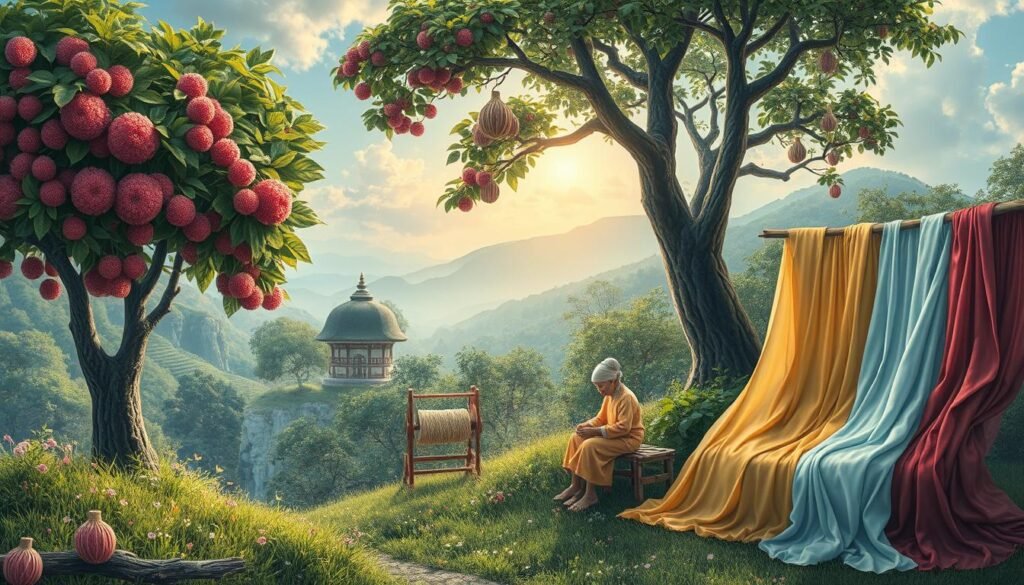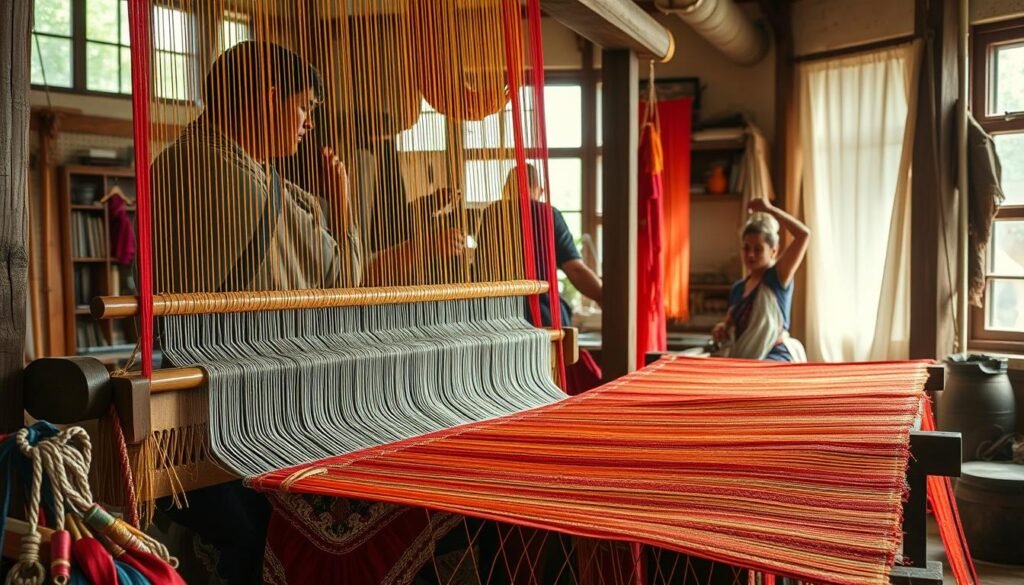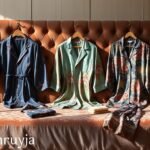Imagine wearing a fabric as soft as a whisper, as bright as starlight, and as strong as steel. Welcome to the world of silk, the top fabric for centuries. It’s known for its beauty, strength, and many uses. From ancient China’s courts to today’s fashion shows, silk has won hearts worldwide. This guide will cover silk’s history, features, making, and different types. It will help you choose better and improve your style1.
Key Takeaways
- Silk was first used around 3,000 BCE in China, making it one of the oldest known textiles.
- Mulberry silk accounts for 90% of global silk production and is renowned for its exceptional quality and strength.
- Silk fabric ranges from 40-60 grams per square meter in weight and 110-140 centimeters in width.
- There are over 35 different types of silk fabrics, each with unique properties and applications.
- Sustainable silk production methods, such as those using alternative fibers, are gaining traction in the industry.
Origins and History of Silk Cultivation
The story of silk starts in ancient China, around 2696 BC. The Empress Hsi-Ling-Shi, also known as Leizu, found silk when silkworm cocoons fell into her tea2. She grew mulberry trees for the silkworms and made the first silk loom. This began the silk industry in China2.
China kept silk production to itself for many years. It became a valuable item across many empires23.
Silk’s Origins in Ancient China
At first, silk was only for emperors and top officials in ancient China. It showed how rich and important someone was2. Later, silk became a key economic item during the Han dynasty. Farmers paid taxes in silk2.
Silk weaving spread to Korea around 200 BC and to Japan in the 4th century AD2.
Spread of Silk Knowledge to Korea and India
Silk production reached India during the Gupta period (AD 400-600) and became big there2. In the sixth century, Persia started making silk too. The knowledge of silk spread through the Byzantine era2.
“Silk was the most desired and sought-after textile in the ancient world, a symbol of wealth, status, and power.”
| Timeline | Silk Cultivation Milestones |
|---|---|
| 2696 BC | Silk cultivation begins in ancient China, discovered by Empress Hsi-Ling-Shi (Leizu) |
| 200 BC | Silk weaving techniques reach Korea |
| 4th century AD | Silk production spreads to Japan |
| 400-600 AD | Silk weaving techniques reach India during the Gupta period |
| 6th century | Persian silk production begins, with the art of sericulture spreading through the Byzantine era |
Properties and Benefits of Silk
Silk comes from the cocoons of the silk moth, like the mulberry silkworm4. It’s known for being super soft, shiny, strong, and long-lasting. People have loved silk for centuries, thanks to the Silk Road trade routes4.
Silk keeps you cool in the summer and warm in the winter5. It’s great for wearing all year. Silk also stays clean and smells good, lasting a long time5.
Silk is good for people with allergies or sensitive skin5. It doesn’t have dust mites or bacteria. Silk won’t irritate your skin and it absorbs less moisture than cotton5.
Silk is also super soft and shiny, especially mulberry silk5. It’s stronger than steel in some ways5. This makes silk great for many things, from clothes to home decor and industrial uses.
Silk’s special structure makes it so strong, soft, and shiny4. It’s made of proteins that work together in a special way4.
In the end, silk is a top choice for many because of its many benefits. It’s great for keeping you comfortable, safe from allergies, and looking good. Silk has won the hearts of people and businesses everywhere.
Silk Production Process
The silk production journey starts with the silkworm, a tiny but mighty creature. These insects, known as Bombyx Mori, are the main source of the world’s silk. They provide over 95% of the silk we use6.
From Silkworm to Silk Thread
First, the silkworm eats a lot of mulberry leaves. As it grows, it sheds its skin four times before making a cocoon6. In just 3 days, the silkworm spins a cocoon with a silk thread up to 1600 meters long6.
After harvesting the cocoons, the silk threads are unwound and woven into silk fabric. This takes a lot of skill, as each silkworm only makes one strand of silk, about 100 meters long7.
Silk Yield from Silkworms
To make just one pound of raw silk, you need about 2,500 silkworms7. This shows how much work goes into making silk. Each silkworm can make about 1,000 meters of silk filament8. But making a small amount of silk requires a lot of these filaments, showing how rare and valuable silk is.
| Silk Production Metrics | Details |
|---|---|
| Time for silkworms to grow to full size | Around 6 weeks7 |
| Length of silk thread from a single cocoon | Up to 1,600 meters6 |
| Rotations to spin a silk cocoon | Approximately 300,0007 |
| Silkworms needed to produce 1 pound of raw silk | Around 2,5007 |

The silk production process is amazing, showing nature’s beauty and human creativity. From the silkworm to the luxurious fabric, each step is fascinating. By learning about silk production, we value this timeless textile more. Visit TryISilk to see the beauty of silk for yourself786.
Varieties of Natural Silk
In the world of silk, there are many types, each with its own special features. The top four varieties that shine are Mulberry, Eri, Tussar, and Muga silk9.
Mulberry Silk: The Premium Choice
Mulberry silk is the most common type, making up about 90% of the world’s silk10. It’s known for its shiny look, soft feel, and great strength9. This silk comes from silkworms that eat mulberry leaves. It’s white and has no smell9.
Other Natural Silk Types
There are other silk types too. Eri silk is a kind that doesn’t harm animals. It’s made from the Samia cynthia ricini silkworm and is known for its shine and toughness10. Tussar silk has a golden look and a special texture. It’s often used in traditional Indian clothes10. Muga silk is rare and found only in Assam, India. It’s known for its golden shine and strength10.
Each type of natural silk has its own special qualities. They meet the needs of fashion lovers and textile experts9109.
Exploring Different Types of Silk Fabrics
The world of silk fabrics is vast and fascinating. It offers many options for designers, fashion lovers, and those who love textiles. Each type of silk has its own special properties and uses11. Mulberry silk and others like charmeuse, chiffon, georgette, and crêpe de Chine are well-known12.
Mulberry Silk Fabrics
Mulberry silk is known as the finest and most luxurious silk. It is loved for its softness, shine, and strength13. This silk comes from the Bombyx mori silkworm, which eats mulberry leaves. Mulberry silk is famous for its smooth and shiny feel. It’s often used in high-end clothes, accessories, and home decor.
Charmeuse, Chiffon, Georgette, and Crêpe de Chine
There are many other silk fabrics that are popular in fashion12. Charmeuse looks like satin because it shines so much. Chiffon is very light and stretchy, perfect for special events and weddings12. Georgette is a bit heavier than chiffon but also drapes well. Crêpe de Chine is from Southern India and is known for its unique texture and comfort13.
These different silks let designers, textile lovers, and buyers explore the many uses of this amazing natural fiber111213.
The Art of Silk Weaving
Silk weaving has a long history that goes back thousands of years. It starts with the careful raising of silkworms for their silk. Skilled weavers use different techniques to make various silk fabrics. Each type has its own special properties.
Plain Weave Silk Fabrics
The plain weave is the simplest silk technique. In this method, the weft threads go over and under the warp threads. This makes a smooth, light, and strong fabric.14 This silk is used for blouses, dresses, and other light clothes. It’s also used for lining and decorations.
Twill Weave Silk Fabrics
Twill weave silk has a special diagonal pattern. The weft threads go over two or more warp threads, then under one. This makes a fabric that’s soft and has a subtle shine. Twill weave silk, like dupioni silk, is great for suits, ties, and heavy clothes.14
Satin Weave Silk Fabrics
The satin weave makes a smooth, shiny silk fabric. In this method, the weft threads float over many warp threads. This gives a mirror-like look.14 Satin silk is used for evening dresses, bridal wear, and luxury clothes.
Each silk weaving technique makes different fabrics for various fashion needs. From the soft plain weave to the shiny satin weave, silk weaving is still exciting for designers and fashion lovers.

“Silk is a textile first derived from a cocoon from the Silkworm, with weaving techniques improving over time.”14
Silk Fabric Care and Maintenance
Proper care is key to keeping silk fabrics looking great. Mulberry silk is known for its softness and durability15. It needs gentle handling to stay luxurious. Charmeuse silk has a shiny look and flows well15. It also needs careful handling to keep its elegance.
For washing silk, use cool water and a mild detergent16. Stay away from harsh chemicals and high heat to avoid damage16. If the label says “Dry Clean Only,” take it to a pro to keep it looking good17.
Silk dries fast, in about 30-60 minutes16. After washing, roll it in a towel to dry it gently. Don’t wring it. Hang it on a rack or padded hanger in a spot with good air flow, but not in direct sunlight17.
Iron silk on a low heat setting to protect the fibers16. Keep silk in a cool, dark spot with good air flow. Use cotton bags to store it to avoid wrinkles16.
By taking good care of it, silk can stay beautiful and luxurious for a long time.
| Silk Fabric Type | Care Recommendations | Key Features |
|---|---|---|
| Mulberry Silk |
|
|
| Charmeuse Silk |
|
|
“Silk is considered one of the strongest natural fibers in the world.”16
A Fine Luxurious Silk Fabric: The Ultimate Fabric Guide
Silk is the top choice for luxury and style. It’s known for being very soft, shiny, and long-lasting. This premier fabric has been a favorite in fashion and home decor for a long time. It’s a top pick for high-end clothes, accessories, and furniture18.
There are many types of silk fabrics, like charmeuse, chiffon, and satin. Each one has its own special qualities. Charmeuse is light and soft, great for dresses, scarves, and lingerie18. Chiffon is also light and stretchy, perfect for special events and everyday clothes18. Georgette is thin and perfect for dresses and scarves18.
Silk is not just for clothes. It’s also a top pick for making your home look fancy. You can use it for bedding, curtains, and even furniture covers1819.
If you want to look or feel more stylish, or make your home look fancy, silk is the way to go. It’s the best fabric for those who want the best181920.
“Silk is the queen of textiles, and textiles are the queens of arts.”
– Robert Curry
Sustainable and Ethical Silk Production
The fashion world is looking at silk production’s sustainability and ethics more closely. Silk is seen as eco-friendly, but it can use a lot of energy and water. It also has issues with labor practices21. The silk industry is linked to high slavery risks in top silk-making countries like China, India, Uzbekistan, and Brazil21.
Environmental Impact of Silk
Making silk uses a lot of water and energy22. It takes 187 kg of mulberry leaves to get just 1 kg of silk21. The silk industry also adds to greenhouse gases. Silk waste can take up to 5 years to break down, longer than polyester’s 200 years23.
Ethical Concerns in Silk Production
There are big labor issues in the silk industry, especially in Uzbekistan and India21. Thousands of kids as young as 5 work in silk, in bad conditions22. Also, silkworms are bred in a way that makes them unable to fly, move, eat, or live long21.
New, better options are being looked at to fix these problems. These include recycled satin, bamboo lyocell, plant-based materials like Naia™ Renew, and spider silk made from yeast, water, and sugar21. By choosing these options, the fashion world can lessen its harm to the planet. This way, silk production can be a luxury we can all enjoy.
FAQ
What is the origin of silk?
Silk started around 3,000 BCE in China. It’s said that the first silk thread was found in a cup of tea by the Emperor’s wife, Lei Zu. She grew mulberry trees for the silkworms and made the first silk loom.
How is silk made?
Silkworms eat mulberry leaves and then make cocoons. The silk threads from these cocoons are unwound and twisted together. It takes about 2,500 silkworms to make one pound of silk. Each cocoon can have a thread almost a mile long.
What are the properties and benefits of silk?
Silk is known for being soft, shiny, strong, and long-lasting. It keeps you cool or warm, takes care of your skin and hair, and is safe for people with allergies.
What are the different types of natural silk?
There are four main types of natural silk: Mulberry, Eri, Tussar, and Muga. Mulberry silk is the most common, making up 90% of silk. It comes from silkworms that eat only mulberry leaves. Mulberry silk is top quality, very strong, white, and has no smell.
What are some popular mulberry silk fabrics?
Popular mulberry silk fabrics include charmeuse, chiffon, georgette, and crêpe de Chine. Each has its own special properties and uses.
What are the different silk weaving techniques?
Skilled weavers have made many weaves and techniques over time. These include plain weave, twill weave, and satin weave. Each weave makes a silk fabric with its own unique properties. From soft, light, and strong plain weave to smooth, shiny satin weave.
How should silk be cared for?
Wash silk by hand or on a gentle machine cycle with cold water and mild detergent. Avoid harsh chemicals and high heat, which can damage silk. Dry silk in the shade to prevent color fading. Keep silk in places that breathe well, away from light and dampness.
What are the sustainability and ethical concerns in silk production?
Silk is seen as eco-friendly as a natural and biodegradable material. But, the silk industry uses a lot of energy and water, and there are concerns over modern slavery and silkworm treatment. To fix this, new ways of making silk from other fibers are being looked into for a more sustainable and ethical silk production.




